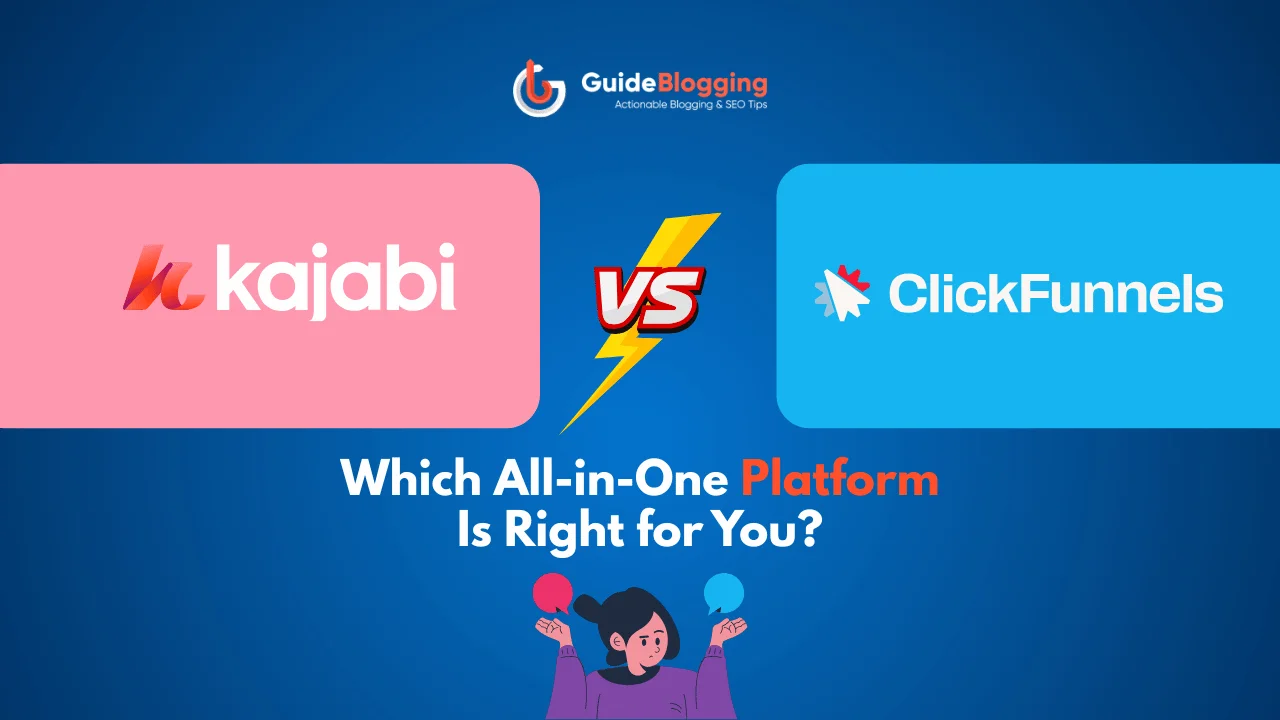Running an online business in 2025 means choosing the right tools to grow efficiently and few decisions are as important as picking between Kajabi vs Clickfunnels.
Kajabi is built for creators who want to launch and deliver digital products without stitching together multiple tools.
Clickfunnels 2.0, on the other hand, focuses on conversion-driven funnels tailored for marketers and ecommerce businesses.
If you’re torn between these two platforms, this comparison will help you make a clear, confident decision based on real features, pricing, and use cases.
Let’s break down Kajabi vs Clickfunnels and see which one truly fits your business goals in 2025.
Table Of Contents
Quick Comparison – Kajabi vs Clickfunnels at a Glance
If you’re in a rush and need a fast breakdown, this side-by-side comparison gives you a clear overview of what both platforms offer.
Whether you’re evaluating based on pricing, features, or usability, here’s how Kajabi vs Clickfunnels 2.0 compare across key areas.
| Feature | Kajabi | Clickfunnels 2.0 |
|---|---|---|
| Primary Use Case | Course creation, coaching, memberships | Funnel building, sales pages, ecommerce |
| Course Creation Tools | Built-in, full-featured course builder | Workarounds required or via 3rd-party integration |
| Sales Funnel Software | Pre-built pipelines with email & page templates | Advanced funnel customization with triggers, steps, and split testing |
| Email Marketing Automation | Native automation with visual editor, tagging, segmentation | Actionetics (built-in) or external integrations like Mailchimp |
| Landing Pages | Clean drag-and-drop builder with blog functionality | Funnel-first pages optimized for conversion |
| Membership Site Support | Native memberships with gated content, community spaces | Limited options unless integrated with other tools |
| CRM and Automation | Visual workflows, customer tagging, analytics | Funnel-logic CRM with actions, delays, condition-based workflows |
| Trial Period | 14-day free trial | 14-day free trial |
| Best For | Educators, course creators, digital product sellers | Marketers, sales teams, ecommerce-driven businesses |
| Pricing (Entry-Level) | Starts at $149/month | Starts at $97/month |
| Blogging & SEO Tools | Native blogging system, SEO fields, easy updates | No native blog, limited SEO features |
| Mobile App | Yes (Kajabi mobile app) | No native app |
| AI Features | Pre-written pipeline copy, smart email subject line suggestions | Smart funnel suggestions and automated flows |
Understanding the Core Purpose – Kajabi vs Clickfunnels User Intent
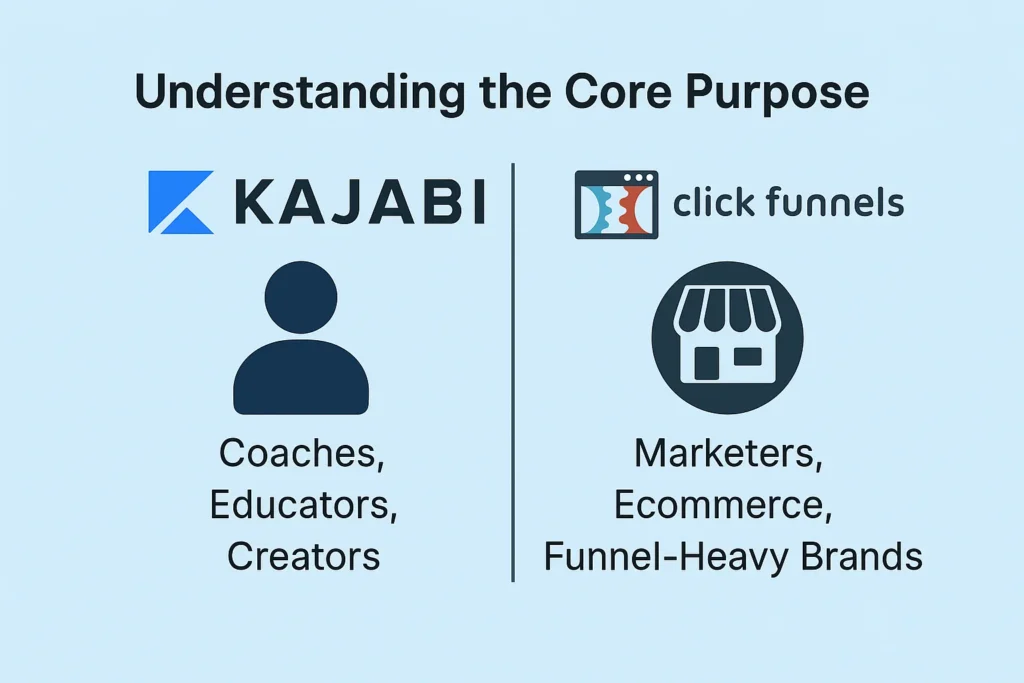
Choosing between Kajabi and Clickfunnels goes beyond comparing features.
It’s about understanding your goals and selecting the platform aligned with your business model.
Whether you’re a coach launching an online course or a marketer optimizing product funnels, your intent defines the better fit.
Kajabi: Ideal for Coaches, Educators, and Digital Product Creators
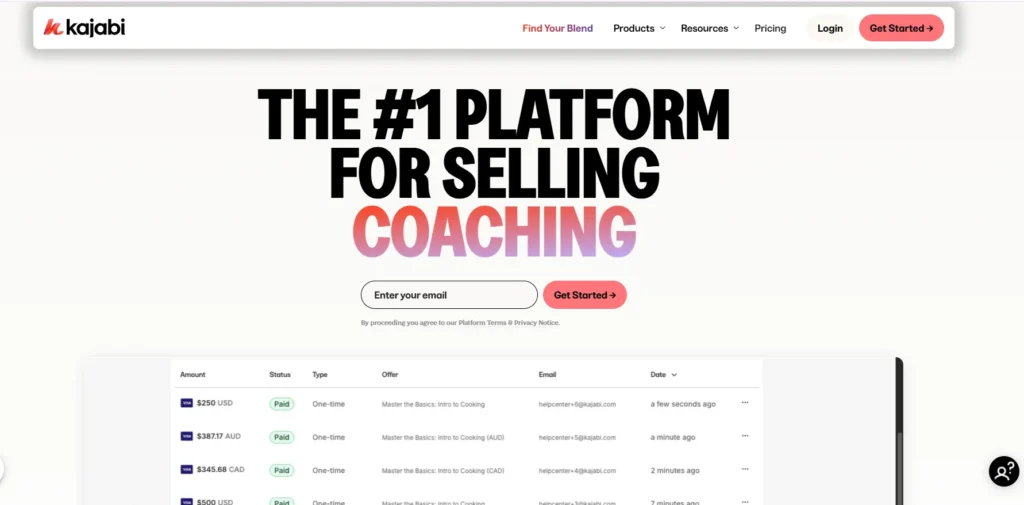
If your focus is on course creation, content delivery, and nurturing long-term student or member relationships, Kajabi stands out as a natural choice.
It’s built with creators in mind those who sell knowledge, offer coaching programs or build membership communities.
Kajabi supports:
- Coaches offering transformation programs
- Educators launching structured online courses
- Content creators building digital product platforms
- Entrepreneurs offering gated content and paid newsletters
For example, suppose you sell online courses or host a coaching community.
In that case, Kajabi simplifies your workflow by combining a course builder, email marketing automation, and membership site platform into one dashboard.
Its visual email editor, branded website builder, and mobile app give creators full control without needing a developer.
This makes Kajabi perfect for online coaching, info products, and recurring subscription models.
It functions less like a traditional funnel tool and more like a creator-focused marketing platform.
Clickfunnels: Best for Marketers, Agencies, and Ecommerce Sales Funnels
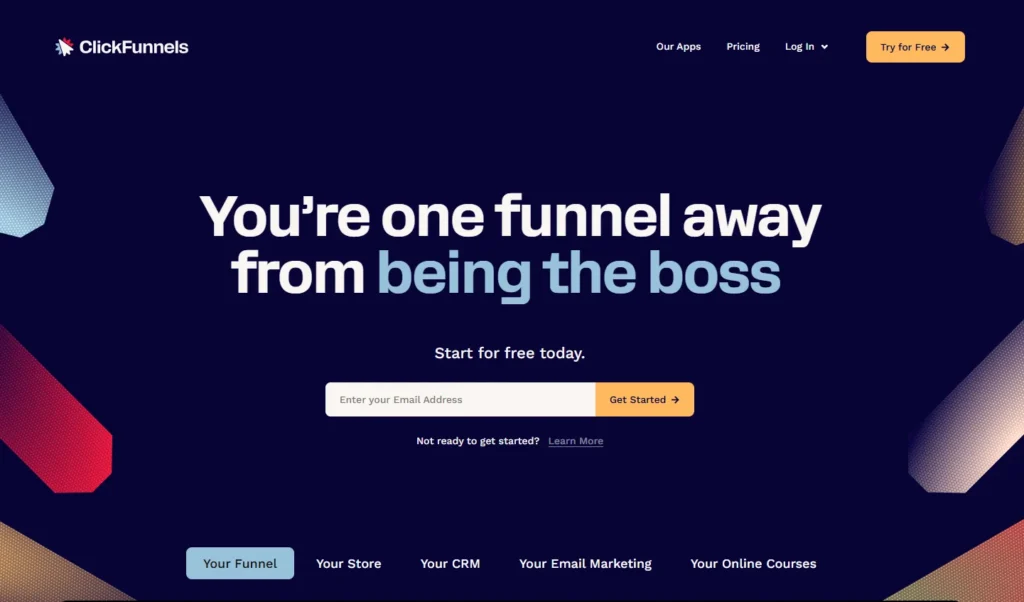
Clickfunnels, particularly with the upgrades in Clickfunnels 2.0, focuses on conversion-first strategies.
It appeals to marketers who prioritize sales funnels, upsells, landing pages, and optimized buyer journeys.
Clickfunnels suits:
- Digital marketers running product launches or webinars
- Small business owners scaling ecommerce offers
- Agencies building client funnels
- High-volume funnel testing and split optimization
If you’re someone building rapid-fire pages to convert cold traffic, or you rely heavily on upsells and email automation for digital or physical product sales, Clickfunnels is the better tool.
Its powerful funnel logic and split-testing capabilities allow for granular optimization of every sales step.
So if you’re a small business leveraging paid ads, ClickFunnels offers the tools to build and scale with precision.
Course Creation & Membership Delivery Experience
When it comes to launching a digital course or building a membership program, your platform must do more than just host content it should guide your audience through a structured learning journey.
This section breaks down the course creation capabilities and membership delivery systems of both Kajabi and Clickfunnels, giving you a clear view of how each supports creators.
Kajabi: Built-In Course Builder and Structured Learning Experience
Kajabi was designed with educators, coaches, and knowledge entrepreneurs in mind.
Its native course builder allows you to create structured content with modules, lessons, downloadable resources, video hosting, and assessments all without relying on third-party tools.
You can schedule content with drip schedules, restrict access by tier, and track learner progress.
Kajabi’s backend even offers an intuitive student dashboard, where users can view completed lessons, access bonus content, and resume learning at any point.
It’s more than just uploading videos.
Kajabi functions as a digital product delivery system where the user experience is seamless, especially on mobile.
Whether you’re delivering a coaching program, digital workshop, or multi-week course, Kajabi handles everything from login to certification.
Additionally, it allows you to create a membership site platform with gated access, community spaces, and subscription options—all native to the Kajabi ecosystem.
Clickfunnels: Limited Course Support via Workarounds
Clickfunnels wasn’t originally designed for education-based content.
While you can technically deliver courses using funnel pages or integrate with external tools like Thinkific or Teachable, it’s not a native experience.
You’ll need to string together multiple steps to deliver a course-like experience, such as using custom pages as modules or hiding URLs behind purchase triggers.
This creates friction for both creators and learners, especially when compared to Kajabi’s built-in course flow.
For memberships, Clickfunnels can technically gate content using its sales funnel software, but it lacks the progress tracking, UX polish, and student analytics that Kajabi offers natively.
Student Management: Kajabi’s Clear Advantage
From tracking lesson completions to issuing certificates and sending automated follow-ups based on user behavior, Kajabi’s student management tools are far more robust.
It empowers creators to not only deliver content but also enhance completion rates and learner engagement.
So, does Kajabi have a sales funnel?
Yes, and it integrates seamlessly with your courses and memberships.
Kajabi includes prebuilt pipelines that combine landing pages, checkout flows, and email campaigns—all optimized for digital product delivery.
Website, Blog, and Landing Page Design

For creators and marketers building a digital presence, the design and functionality of your website play a central role in visibility and conversion.
In this section, we compare how Kajabi and Clickfunnels handle landing page building, website UX, and blogging features, helping you determine which platform meets your creative and technical expectations.
Kajabi: Full Website Capabilities with Blogging and SEO Control
Kajabi offers a well-rounded solution for creators who want their platform to serve as a website, content hub, and sales engine.
The drag and drop page editor makes it easy to customize sections, manage themes, and create responsive designs all without needing to write code.
Beyond page design, Kajabi includes a fully functional blog feature, allowing you to publish and manage SEO-optimized posts.
This is especially valuable for driving organic traffic and building topical authority over time.
Its SEO tools include:
- Meta title and description fields
- Image alt tags
- Canonical URLs
- Custom slugs and 301 redirects
This makes Kajabi more than just a landing page builder—it’s a true no-code funnel builder and website solution for educators, coaches, and content creators who want everything under one roof.
Clickfunnels: Funnel-Focused Builder with Limited Web Presence Tools
Clickfunnels 2.0 has improved its UI over the previous version, with a more polished editor and improved mobile responsiveness.
However, it still prioritizes conversion-focused funnels over comprehensive website features.
While it functions well as a landing page builder, it lacks a blogging system and has limited support for long-form content.
For creators looking to publish regular articles, tutorials, or SEO-driven posts, this can be a major limitation.
Clickfunnels does offer a drag and drop editor, but it’s mostly tailored for funnel flows and sales pages rather than full-fledged websites.
While you can technically create static content pages, they’re not ideal for blogging or long-term SEO growth.
SEO controls exist, but they’re minimal in comparison to Kajabi.
Custom meta fields are available per page, but deeper SEO customizations often require workarounds or external tools.
Funnel Building & Automation – Which is More Powerful?
When evaluating Kajabi vs Clickfunnels, one of the most critical aspects for marketers and digital product creators is how each platform handles funnel building and automation workflows.
Funnels aren’t just about designing landing pages they’re the engine behind your customer journey, and how you execute them can make or break your conversions.
Clickfunnels: A Funnel-First Powerhouse for High-Converting Journeys
Clickfunnels 2.0 builds on its legacy as a funnel-first platform, optimized for marketers who want granular control over every step of the buyer journey.
Its funnel builder is designed around trigger-based flows, offering flexibility in how leads move through pages, offers, upsells, and thank-you sequences.
Users can design detailed funnels using an intuitive drag-and-drop interface, while applying A/B testing tools to compare performance at each stage.
Funnels in Clickfunnels can be custom-built from scratch or selected from a library of templates tailored for webinars, product launches, lead magnets, and ecommerce campaigns.
It’s particularly powerful when paired with its native marketing automation software, allowing users to trigger emails, actions, and webhooks based on user behavior within funnels.
For those who rely on sales funnels as their core conversion engine especially in ecommerce or paid advertising Clickfunnels delivers unmatched control and optimization features.
Kajabi: Simplified Funnel Execution with Prebuilt Pipelines
While Kajabi isn’t strictly a funnel-building tool in the traditional sense, it excels at delivering ready-to-launch pipelines that combine landing pages, opt-in forms, checkout flows, and follow-up email sequences all pre-written and professionally designed.
This funnel system is ideal for creators who value speed and efficiency.
Kajabi’s automation workflows are tightly integrated with its course builder, membership system, and email marketing automation, allowing you to tag users, assign offers, send sequences, and personalize their journey without needing third-party tools.
So, how do Kajabi’s pre-built funnels save time vs ClickFunnels?
Kajabi removes the need to write copy, design layouts, or stitch tools together.
You can select a pipeline (e.g., product launch, freebie opt-in), customize basic details, and go live—all within minutes.
For many creators, this convenience outweighs the granular customization offered by Clickfunnels.
Automation: Kajabi’s Simplicity vs Clickfunnels’ Depth
- Kajabi’s automation is designed for course creators and membership businesses. It uses a visual rule-builder to trigger actions like email delivery, content access, or user tagging based on events such as form submissions or lesson completions.
- Clickfunnels’ automation allows for advanced flows and integrations with tools like Zapier and Stripe, ideal for marketers running high-velocity campaigns.
Ultimately, Kajabi offers streamlined automation built into your course or product experience, while Clickfunnels gives you deep funnel customization and testing for traffic-heavy campaigns.
Email Marketing & CRM Features

Effective email marketing is at the core of any successful digital business, especially when building relationships, driving sales, and nurturing leads.
Whether you’re automating welcome sequences or launching promotional campaigns, your platform’s ability to handle email workflows and CRM integration plays a crucial role.
In this section, we break down how Kajabi vs Clickfunnels compare when it comes to email marketing automation and customer relationship management tools so you can choose the one that aligns with your business model.
Kajabi: Streamlined Email Tools for Course Creators and Coaches
Kajabi offers an all-in-one solution that includes a visual email editor, customizable templates, and native automation logic.
You can create segmented lists based on behavior, product access, form submissions, and more without relying on external email tools.
Using Kajabi’s email marketing automation, creators can:
- Design branded broadcasts and automated campaigns
- Build visual workflows based on user actions (e.g., video watched, quiz completed)
- Tag contacts, segment audiences, and schedule follow-ups
The interface is clean and intuitive, making it ideal for those who want a creator-focused email campaign builder without a steep learning curve.
You also get access to analytics for open rates, click rates, and revenue attribution from email-based campaigns.
The real strength lies in how Kajabi’s CRM system is tightly integrated with every action a user takes across your website, courses, and pipelines.
You don’t need a separate tool to build complete customer journeys—it’s all native.
Clickfunnels: Powerful Automation via Actionetics (or 3rd-Party Tools)
Clickfunnels includes its proprietary tool called Actionetics, which allows users to create targeted email sequences and broadcast campaigns.
While functional, it’s not as visually intuitive as Kajabi’s editor and is better suited to users already familiar with complex automation tools.
You can also integrate Clickfunnels with third-party tools like Mailchimp, ConvertKit, or ActiveCampaign if you prefer more advanced segmentation or deliverability tracking.
Clickfunnels excels when tied into its funnel builder, allowing for precise CRM workflows and event-based triggers like cart abandonment, upsell behavior, or product purchases.
These actions can launch sequences, apply tags, or sync data with external platforms.
In terms of customer relationship management tools, Clickfunnels offers flexibility, but it often requires layering in other services for full-scale marketing operations.
Checkout, Payments, & Subscriptions
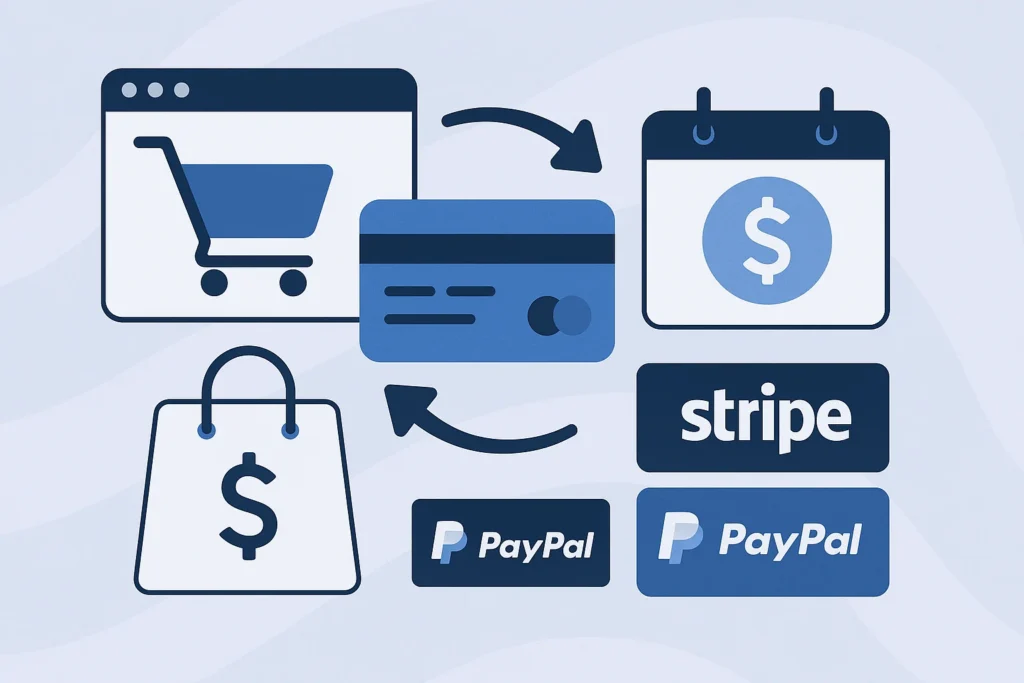
When selling digital products, courses, or memberships, a seamless checkout experience can significantly impact your revenue.
It’s not just about processing payments your platform needs to support upsells, handle recurring billing, and reduce friction at every step.
In this section, we examine how Kajabi vs Clickfunnels compare in checkout optimization, subscription billing, and payment processing, helping you determine which platform can drive more conversions with less hassle.
Kajabi: Simplified Checkout and Built-In Subscription Management
Kajabi includes a native checkout system that’s clean, minimal, and built with creators in mind.
Whether you’re selling a one-time product, recurring membership, or multi-tiered course bundle, the platform allows you to customize offers with pricing options, coupons, and upsells.
While Kajabi doesn’t have advanced cart abandonment recovery natively, it integrates with email automation to re-engage potential customers who didn’t complete their purchase.
The checkout is mobile-optimized and supports Stripe and PayPal as secure payment gateways.
Recurring payments are handled through Kajabi’s subscription billing platform, where users can create plans with trial periods, billing intervals, and automatic access control.
You can even segment subscribers by plan for email targeting.
Kajabi excels in delivering a frictionless purchase flow, especially for creators prioritizing ease over deep funnel logic.
Clickfunnels: Aggressive Sales Optimization with Advanced Funnel Triggers
Clickfunnels, on the other hand, takes a conversion-first approach to checkout.
With built-in tools for upsells, downsells, and one-click order bumps, you can design highly optimized sales sequences that maximize cart value.
Its funnel system allows you to place offers post-checkout or at strategic points during the buying journey, ideal for ecommerce sellers or high-ticket funnels.
The checkout templates are flexible, and you can track performance through A/B testing and analytics.
Clickfunnels supports Stripe and PayPal as its primary payment processors, but it shines in its checkout optimization software giving marketers the ability to tweak every step, split-test versions, and build urgency through timers and scarcity elements.
Subscription payments are possible, but managing them often requires third-party tools or custom webhook flows.
This may introduce complexity for users who prefer an all-in-one setup.
So, is Clickfunnels worth it when it comes to payment and checkout logic? For businesses running aggressive sales funnels or needing custom control over upsells, the answer is yes.
But for creators focused on simplicity and stability, Kajabi may offer a more practical billing environment.
Affiliate Program Management
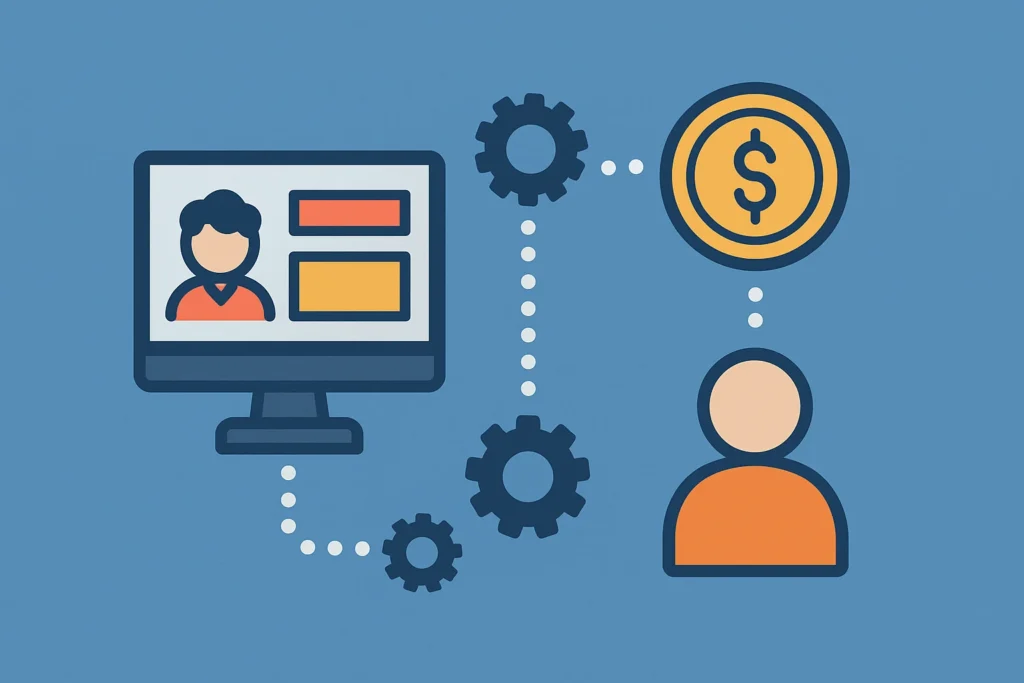
A well-structured affiliate program can become a powerful growth engine—especially for digital creators, course sellers, and marketers who rely on partnerships to expand reach and generate passive revenue.
In this section, we’ll explore how Kajabi vs Clickfunnels compare when it comes to affiliate marketing support, setup simplicity, and payout management.
Kajabi: Streamlined Affiliate Tools for Digital Creators
Kajabi includes a built-in affiliate marketing system, allowing creators to manage their own affiliate programs directly within the platform—without the need for external plugins or tools.
Setting up your program is straightforward.
You can generate custom affiliate links, assign offers to specific partners, and set commission percentages on a per-product basis.
Kajabi allows for commission flexibility, supporting one-time payments or recurring commissions based on subscription billing.
Each affiliate gets access to a personal dashboard where they can track clicks, signups, and payouts.
From the admin side, Kajabi provides basic payout tracking, though actual payments need to be processed manually via PayPal or another payment processor.
This system works well for solo creators, educators, or course businesses looking to build a referral ecosystem without investing in third-party affiliate tools.
It’s a practical solution for those seeking content monetization tools without the tech complexity.
Clickfunnels: Affiliate Management via Backpack (Higher Plans)
Clickfunnels offers affiliate features through its Backpack add-on, available only on its higher-tier pricing plans.
Once enabled, Backpack functions as a full-featured affiliate marketing support system designed for funnel-focused businesses.
You can:
- Create tiered commission structures
- Track affiliate performance in real-time
- Set up promotional contests
- Offer bonuses or milestone rewards
The affiliate dashboard is more detailed than Kajabi’s, with advanced tracking options and integrated triggers tied to the funnel builder.
Payout automation can be handled through webhook integrations or linked services, depending on your tech stack.
However, Backpack requires more configuration and comes at a higher cost, which may not be ideal for creators just starting out.
But for marketers managing large affiliate campaigns or running multi-product funnels, the flexibility is unmatched.
Integrations & Mobile App Experience
As your digital business grows, you’ll need more than just landing pages and email sequences you’ll need a platform that integrates smoothly with third-party tools and gives users access across devices.
In this section, we compare how Kajabi vs Clickfunnels handle integrations, automation workflows, analytics, and mobile usability.
Kajabi: Native Mobile App and Creator-Friendly Integrations
Kajabi provides a native mobile app for iOS and Android, offering students and members direct access to course materials, communities, and downloadable content—all from their devices.
For course creators, this means less friction and more engagement, especially for programs that rely on mobile learning or on-the-go consumption.
So, what makes Kajabi’s mobile app better for course delivery?
Unlike Clickfunnels, Kajabi’s mobile app is purpose-built for learning.
Students can resume content, track progress, receive push notifications, and interact with communities without ever needing to open a browser.
This creates a streamlined experience for subscription-based courses and membership content.
On the integration side, Kajabi connects easily with Zapier, enabling automations across platforms like ConvertKit, Calendly, Google Sheets, and more. For instance:
- Auto-enroll a student when they complete a Typeform quiz
- Trigger email sequences based on form submissions
- Add leads to CRM systems in real-time
Kajabi also supports calendar sync, webinar hosting platforms like Zoom or WebinarJam, and basic analytics tools for tracking page views, video consumption, and user behavior all from within the dashboard.
For creators who need essential lead capture tools and marketing stack integrations, Kajabi covers most of the core use cases out of the box.
Clickfunnels: Flexible Integrations, But No Mobile App
Clickfunnels integrates with dozens of third-party tools through Zapier, giving marketers flexibility to connect their funnel data with external CRMs, email tools, or payment gateways.
Use cases include:
- Syncing leads to Google Sheets or HubSpot
- Triggering webhook events after purchases
- Automating SMS notifications through Twilio
However, unlike Kajabi, Clickfunnels does not offer a mobile app, which can limit engagement for users consuming content or offers on mobile.
This gap may not affect funnel-centric marketers, but it can be a disadvantage for course creators or those managing community-based programs.
Clickfunnels is also better suited for ecommerce funnel builders, especially those who require advanced triggers or cart abandonment workflows.
Integration with tools like Stripe, ShipStation, and analytics platforms helps marketers build robust conversion paths.
Webinar tools are supported via external integrations, but Clickfunnels doesn’t natively support hosting or managing webinars within the platform.
If you’re managing evergreen webinar platforms or automation-heavy launches, Clickfunnels offers flexible configurations though you’ll often rely on third-party tools to achieve it.
AI & Automation – The 2025 Edge

Artificial intelligence is no longer a futuristic concept it’s now a core part of how creators scale their businesses.
When evaluating Kajabi vs Clickfunnels, it’s important to consider how each platform leverages AI and automation to streamline content creation, funnel building, and customer engagement.
While both platforms offer automation workflows, the integration of AI tools in ClickFunnels 2.0 and Kajabi creates distinct advantages depending on your goals as a creator or marketer.
ClickFunnels 2.0: AI for Smart Funnel Suggestions and Automation Triggers
ClickFunnels 2.0 introduces AI-powered tools that help users build optimized funnels faster.
One of its standout features is the Smart Funnel Builder, which suggests funnel structures, page types, and even copy variations based on your product type or business model.
The platform uses historical data and behavioral inputs to recommend:
- Funnel sequences for lead generation, product launches, and ecommerce
- A/B test combinations for higher conversions
- Content layouts that match your audience’s intent
ClickFunnels also incorporates AI into its automation engine, allowing users to set advanced triggers, branching logic, and smart delays that adjust to user actions.
This makes it a strong platform for creator-focused automation when performance testing and scaling ad-driven funnels are priorities.
Kajabi: AI That Simplifies Content and Email Execution
Kajabi approaches AI with a creator-first mindset.
Instead of overwhelming users with options, it embeds AI into everyday actions like:
- Email subject line optimization, where it suggests high-converting headlines based on intent and language patterns
- Prewritten pipeline templates, including full copy blocks for landing pages, email sequences, and CTAs tailored to common use cases like course launches or lead magnets
This functionality is ideal for solo creators or digital educators who want to move quickly without hiring a copywriter or funnel strategist.
Kajabi’s automation engine also enables personalized user journeys based on actions like video completion, opt-ins, or purchases.
Triggers can assign tags, unlock content, or initiate follow-up emails all of which support knowledge commerce tools in scaling efficiently.
Which AI-Powered Platform Helps Creators Scale Faster?
ClickFunnels excels in performance-driven environments where marketers need to test, optimize, and iterate at scale.
Kajabi shines when ease, speed, and low-friction content execution are the priority.
Both platforms support creator-focused automation, but their AI is built for different types of entrepreneurs.
If you’re a performance marketer running traffic-heavy campaigns, Clickfunnels 2.0 gives you data-driven tools to refine every step.
If you’re a creator building courses, communities, and coaching programs, Kajabi’s AI lets you focus on content while the system handles the funnel logic.
Pricing Comparison – Which Platform is More Cost-Effective?
Pricing is often the final deciding factor when choosing between Kajabi vs Clickfunnels, especially when you’re comparing feature access, support levels, and scalability.
But cost isn’t just about the monthly bill—it’s about the value you get from the tools included in your plan.
Let’s break down the current plans of both platforms to see which one offers more value for creators, marketers, and small business owners.
Plan Breakdown: Kajabi vs Clickfunnels 2.0
| Feature | Kajabi Kickstarter | Kajabi Basic | Kajabi Growth | Kajabi Pro | ClickFunnels Startup | ClickFunnels Pro |
|---|---|---|---|---|---|---|
| Monthly Price | $89 | $149 | $199 | $399 | $97 | $297 |
| Annual Price (20% off) | $71 | $119 | $159 | $319 | $81 | $248 |
| Products | 1 | 3 | 15 | 100 | Unlimited | Unlimited |
| Funnels | 1 | 3 | 15 | 100 | Unlimited | Unlimited |
| Contacts | 250 | 10,000 | 25,000 | 100,000 | Unlimited | Unlimited |
| Active Members | 50 | 1,000 | 10,000 | 20,000 | Unlimited | Unlimited |
| Websites | 1 | 1 | 1 | 3 | Unlimited | Unlimited |
| Admin Users | 1 | 1 | 10 | 25 | 3 | 10 |
| Landing Pages | Unlimited | Unlimited | Unlimited | Unlimited | Unlimited | Unlimited |
| Marketing Emails | 7,500 | Unlimited | Unlimited | Unlimited | Unlimited | Unlimited |
| AI Features | Yes | Yes | Yes | Yes | Not specified | Not specified |
| Advanced Automations | No | No | Yes | Yes | Yes | Yes |
| Affiliate Program | No | No | Yes | Yes | No | No |
| Custom Branding | No | No | Yes | Yes | Yes | Yes |
| 24/7 Support | No | No | Yes | Yes | Yes | Yes |
| Custom Code Editor | No | No | No | Yes | No | No |
| Transaction Fees | 0% | 0% | 0% | 0% | 0% | 0% |
Monthly vs Annual Savings
Kajabi offers notable savings when billed annually—bringing down the Basic plan to $119/month.
Clickfunnels also offers discounts for yearly subscriptions, but only applies those benefits to their feature upgrades, not overall user flexibility.
Clickfunnels’ entry-level plan is slightly more affordable than Kajabi’s, but lacks the email marketing, affiliate system, and blogging tools included in Kajabi’s Basic plan.
When comparing actual value, Kajabi gives you more built-in tools without requiring third-party add-ons or higher-tier upgrades.
So if you’re asking, is Kajabi worth it?—the answer depends on whether you need a complete business platform out of the box or just a funnel system.
Which Offers More Value for Money?
Clickfunnels shines if you’re primarily focused on sales funnel optimization, high-volume ad campaigns, or ecommerce-style offers.
It’s purpose-built for marketers who prioritize conversion paths over community, content, or brand-building.
Kajabi, on the other hand, is better suited for digital product creators, coaches, and educators looking for a centralized platform to host content, manage subscribers, send emails, and build membership sites—without stacking additional tools.
So if you’re comparing cost vs capability and wondering what is better than Clickfunnels for an all-in-one creator business, Kajabi comes out ahead in toolset depth and usability for non-tech users.
Pros and Cons of Kajabi vs Clickfunnels
To make the right decision between Kajabi vs Clickfunnels, it’s essential to understand not just the features but also the practical benefits and limitations of each platform.
Below is a balanced breakdown that highlights where each tool excels and where it may fall short—helping you choose based on your unique business goals.
| Kajabi | ClickFunnels 2.0 |
|---|---|
| Pros | Pros |
| Easy-to-use all-in-one platform for courses, memberships, emails, and websites | Industry-leading funnel builder with detailed conversion tracking |
| Built-in course builder with student progress tracking | Deep A/B testing and sales optimization tools |
| No-code visual automation workflows | Smart Funnel Builder with AI-powered suggestions |
| Integrated mobile app for content access and engagement | Strong upsell/downsell and order bump functionality |
| Native community and coaching features | Advanced control over custom funnel paths and page variations |
| Includes blogging and SEO tools | Built-in CRM and affiliate tracking (Backpack on higher tiers) |
This updated table maintains the human-friendly tone and consistent formatting you’ve used throughout your blog.
It also reflects accurate and up-to-date information from verified sources.
Who Should Choose Kajabi?
If you’re a coach, course creator, or digital entrepreneur looking for a creator-first platform that manages your entire business from content delivery to automation—Kajabi offers a polished experience.
It’s particularly ideal for those who want to sell digital products without stitching together multiple tools.
Who Should Choose Clickfunnels?
Clickfunnels is best for marketers and ecommerce-driven businesses that prioritize conversion optimization and custom funnel paths.
If your main goal is to run traffic to landing pages and maximize ROI on paid ads, it offers the testing tools and sales infrastructure to scale fast.
Use Cases – Who Should Choose What
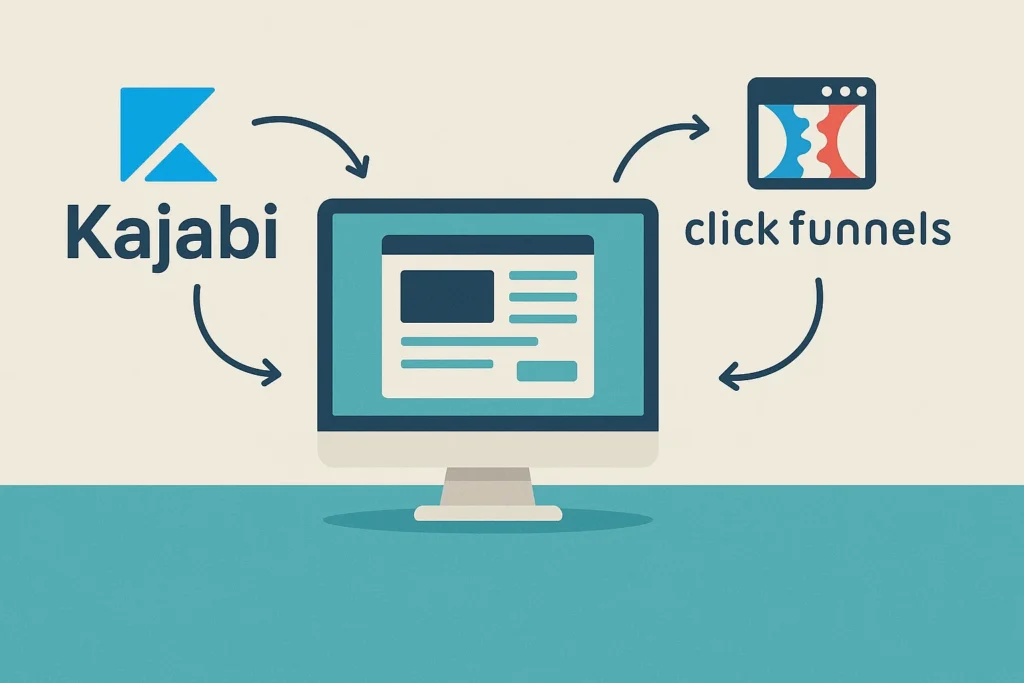
Choosing between Kajabi vs Clickfunnels often depends less on features and more on who you are and what you’re building.
Are you a content creator launching your first course, a service provider scaling a membership program, or a marketer managing multiple sales funnels?
Let’s break down real-world use cases to help you determine the right platform based on your goals and business stage.
If You’re a Digital Coach or Course Creator → Kajabi
Kajabi is purpose-built for educators, coaches, and creators who want to build, market, and monetize digital products.
Its integrated course builder, email marketing automation, and subscription billing platform make it a seamless solution for those selling expertise.
Whether you’re launching a group coaching program, hosting a paid community, or delivering a step-by-step course, Kajabi gives you:
- Branded landing pages and sales pipelines
- Member access areas with progress tracking
- Visual automation workflows tied to lessons and events
- A mobile app to increase course completion rates
This makes Kajabi ideal for creator-focused marketing tools where content delivery, relationship-building, and user experience matter more than complex sales funnel strategies.
If You’re a Performance Marketer or Funnel Strategist → ClickFunnels
ClickFunnels 2.0 is designed for marketers who thrive on optimization, lead generation, and rapid testing.
Its funnel builder offers custom flows with detailed triggers, A/B testing options, and smart automation paths tailored for ecommerce, agencies, and product launches.
If you’re scaling cold traffic through paid ads, running webinar-based lead generation, or need to test variations quickly, ClickFunnels gives you:
- Unlimited page variations and upsell flows
- CRM tagging and dynamic funnel paths
- Access to Backpack for affiliate management (higher tiers)
- Smart Funnel Builder powered by AI
For users who prioritize sales automation tools, ecommerce funnel builders, or want complete control over conversion paths, ClickFunnels is the better choice.
Choosing Based on Business Stage
- Beginners: Kajabi offers an intuitive, all-in-one solution ideal for creators who don’t want to juggle plugins or third-party tools. Everything is built-in—from checkout to content delivery.
- Scaling Creators: If you’re growing your audience and need better automation, analytics, and member segmentation, Kajabi provides scalable workflows without technical friction.
- Advanced Marketers: Clickfunnels shines for funnel-heavy brands or teams running traffic-driven campaigns that rely on optimization, testing, and rapid deployment.
Alternatives to Kajabi and Clickfunnels
While Kajabi vs Clickfunnels remains a common comparison, they aren’t the only options available for building digital businesses.
Depending on your goals, budget, and technical preferences, other platforms might offer more flexibility or a better pricing structure.
If you’re asking what is the best alternative to ClickFunnels, or simply want a tool that combines ease of use with solid marketing capabilities, the following platforms are worth considering.
1. EzyCourse
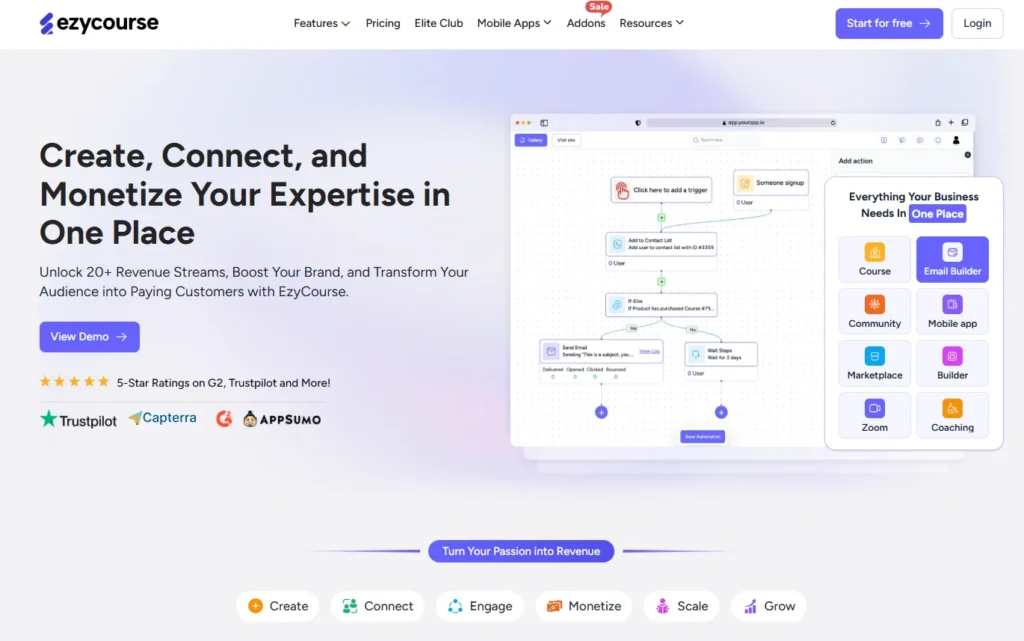
EzyCourse is an emerging all-in-one platform tailored for educators, coaches, and content creators.
It offers built-in features for course hosting, memberships, community engagement, and email marketing all in one dashboard.
Unlike Clickfunnels, it focuses on knowledge commerce tools and supports detailed student management similar to Kajabi.
Ideal for: New creators looking for an affordable, course-first alternative to Kajabi or Clickfunnels
Strengths: Student dashboards, community features, no transaction fees on higher plans
2. Kartra
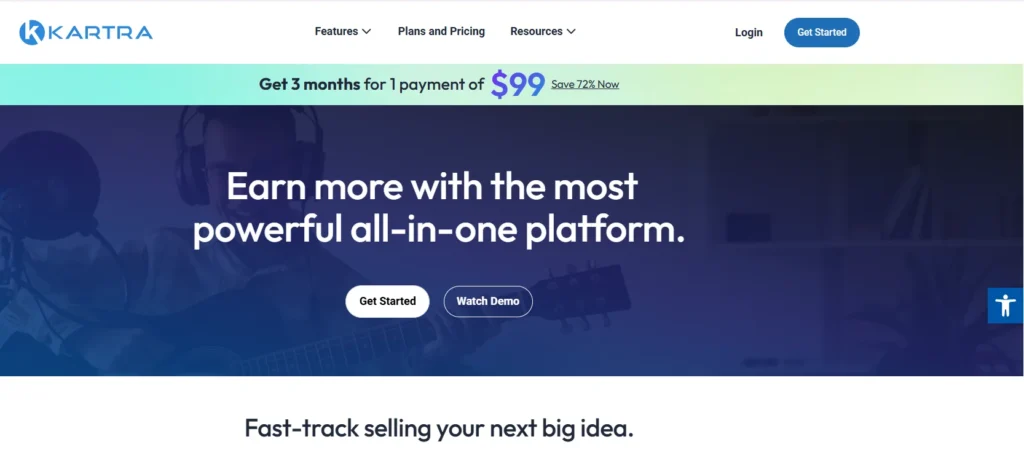
Kartra is a marketing automation platform that blends sales automation tools, landing page design, and membership hosting into one unified experience.
While not as user-friendly as Kajabi, Kartra’s strength lies in its depth offering advanced workflows, checkout optimization, and split testing.
Ideal for: Intermediate marketers or small businesses needing deep funnel logic and robust analytics
Strengths: Powerful automation engine, campaign analytics, affiliate program management
3. Systeme.io
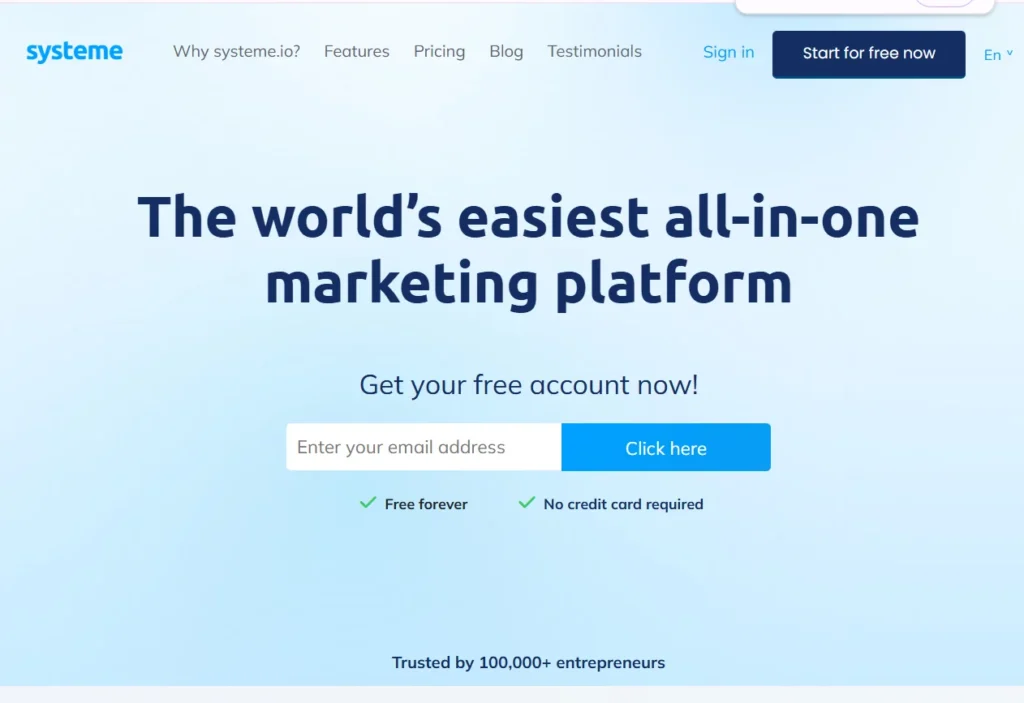
Systeme.io is a budget-friendly ecommerce funnel builder offering core features such as funnels, email marketing, course hosting, and affiliate program tools—all under one roof.
It’s simpler than both Kajabi and Clickfunnels, but that simplicity appeals to solopreneurs and freelancers just starting out.
Ideal for: Beginners and budget-conscious creators who want an all-in-one platform with minimal setup
Strengths: Free plan, built-in blog, easy-to-use funnel templates
Final Verdict – Kajabi vs Clickfunnels: Which Wins in 2025?
After comparing features, pricing, automation, user experience, and integrations, the choice between Kajabi vs Clickfunnels ultimately comes down to your business model and workflow preferences.
Below is a decision matrix to help you assess which platform better fits your current stage and strategic priorities:
| Use Case | Best Choice | Reason |
|---|---|---|
| Selling online courses or coaching programs | Kajabi | Native course builder, email automation, and mobile app for students |
| Running ad-driven, funnel-optimized campaigns | ClickFunnels 2.0 | Deep funnel logic, A/B testing, upsells, and performance-focused tools |
| Launching a membership-based content platform | Kajabi | Built-in membership tools and subscription billing |
| Ecommerce and physical product funnels | ClickFunnels 2.0 | High-converting checkout flows and order bumps |
| Affiliate-driven marketing campaigns | ClickFunnels | Robust affiliate tracking via Backpack (Pro plans) |
| Solo creators or educators needing simplicity | Kajabi | All-in-one dashboard, no-code interface, prebuilt pipelines |
So, is Kajabi the best choice for creators? If you value ease, integration, and a focus on digital content delivery, then yes.
It reduces tech overwhelm and gives you all the essential tools in one ecosystem.
But if you’re focused purely on performance marketing, upsells, and lead conversion, Clickfunnels continues to be a strong contender.
That said, many users today are beginning to compare Clickfunnels and Kajabi not just by features, but by long-term operational efficiency.
💡 Now it’s your turn:
Which platform suits your needs in 2025? Comment below and let us know whether you’re team Kajabi or team Clickfunnels—and why.
FAQs – Kajabi vs Clickfunnels (2025 Update)
Which is better, ClickFunnels or Kajabi?
It depends on your goals. ClickFunnels is ideal for marketers focused on conversion and split testing.
Kajabi is better suited for course creators and digital entrepreneurs who want an all-in-one solution.
Why is everyone leaving ClickFunnels?
Many users are switching due to the high cost, limited blog functionality, and the need for third-party tools to handle things that Kajabi includes natively.
Does Kajabi have a sales funnel?
Yes. Kajabi includes prebuilt funnels known as “Pipelines” with ready-to-use templates for lead magnets, product launches, and webinars.
What is better than Kajabi?
For some users, alternatives like Kartra, Systeme.io, or EzyCourse may offer more flexible pricing or deeper automation features depending on their use case.
What is the best alternative to ClickFunnels?
Kajabi is a top alternative for creators, while Kartra and Systeme.io are popular among those looking for more affordable funnel-building solutions.
How does Kajabi’s community feature enhance student engagement?
Kajabi includes built-in community spaces where students can interact, post updates, and stay engaged outside of their lessons, boosting retention and course completion.
What makes Kajabi’s mobile app better than ClickFunnels?
Kajabi has a native mobile app that allows users to access content, communities, and downloads on the go.
Clickfunnels doesn’t offer this capability.
Why is Kajabi more suitable for course creators?
Kajabi combines a course builder, website, CRM, email automation, and checkout—all in one place—removing the need for multiple tools.
How do Kajabi’s prebuilt funnels save time vs ClickFunnels?
Kajabi’s funnels come with pre-written copy and page sequences designed for common use cases, allowing creators to launch faster with minimal customization.
How does Kajabi’s all-in-one approach help course creators?
It centralizes content delivery, email, landing pages, and sales tracking under one roof—reducing tech complexity and saving costs in the long run.
Also Read:
- 9 Best Affordable Bluehost Alternatives That Saves Your Money
- Canva Alternatives 2025 – Better and Cheaper Than Canva at Zero Monthly Fee?
- Clickfunnels Pricing 2025- Which Plan Suitable For Your Business ?
